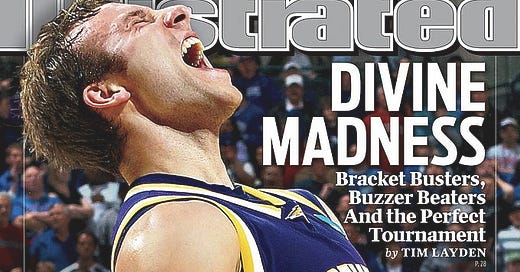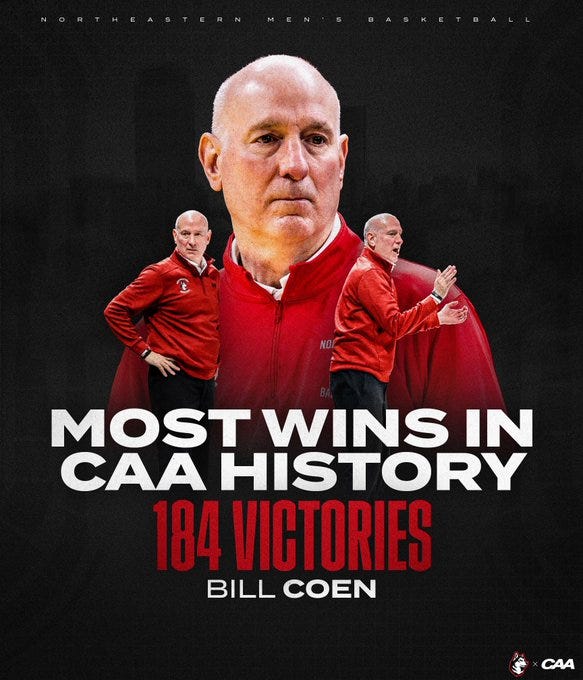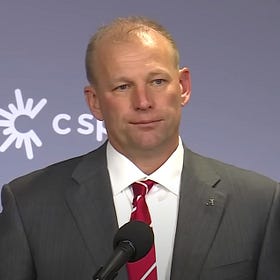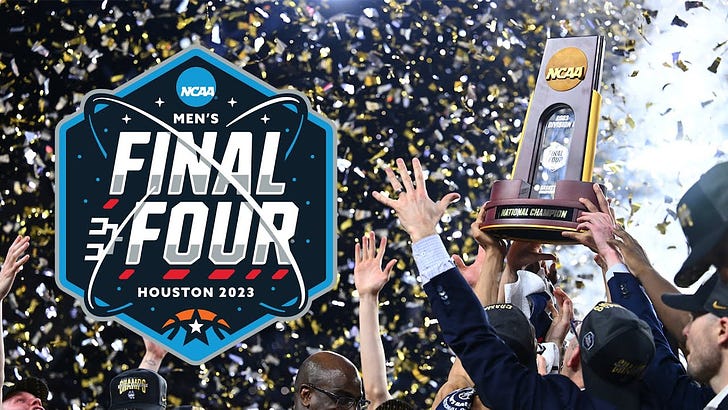A Weekend for Living Legends in College Basketball
Stars aligned for an especially unique day in college basketball. With Northeastern’s 84-72 defeat of Elon, Bill Coen became the all-time winningest coach in Coastal Athletic Association history; North Florida’s 91-75 win over Queens made Ospreys coach Matt Discroll the all-time ASUN wins leader; and Ben Jacobson reached No. 1 all-time in Missouri Valley history with Northern Iowa’s 61-57 win against Southern Illinois.
While each set his respective conference’s career wins mark on the same Saturday, the three followed different paths that led them there.
Coen came to a Northeastern program where a predecessor who arguably belongs on a College Basketball Mount Rushmore casts a long shadow.
When Coen was nearing Northeastern’s all-time wins mark during the 2020-21 season, I wrote this story on his pursuit of Jim Calhoun. Calhoun coached NU to unprecedented heights in the 1980s before turning a long-struggling UConn into a national powerhouse.
Calhoun spoke with me at length about what it takes to win at a program like Northeastern, and the traits that have made Coen successful.
Coen didn’t directly follow Calhoun, who accepted the UConn job in 1986 after the Huskies made appearances in 6-of-7 NCAA Tournaments. However, the 20 years between Calhoun’s exit and Coen’s arrival underscore the difficulty programs face when replacing legends.
Wendell Barnhouse’s column here at The Press Break in the wake of Nick Saban’s retirement touches on the phenomenon, most notably encapsulated at UCLA.
It’s been about a half-century since John Wooden retired at the conclusion of the most successful tenure in major team sports coaching history. Wooden’s legacy left a measuring stick that no successor can ever stack up to, which in turn has cultivated an angst around UCLA basketball that’s difficult to describe but almost tangibly evident.
Before Coen’s hire in 2006, Northeastern had four different head coaches between Calhoun and him. Karl Fogel, the immediate successor to Calhoun, was the only of the three to bring the Huskies back to the NCAA Tournament, and he did so once immediately after (1987) and the last time in 1991.
Dave Leitao, a longtime Calhoun assistant both at Northeastern and UConn, lasted only two seasons — the second of which ended in a 4-24 finish, worse than Fogel’s 5-22 swan song.
The four-win 1996 began a string of seven straight .500-or-worse (six being “worse”0 finishes at Northeastern, which spanned the duration of Rudy Keeling’s tenure. Only when Ron Everhart went 16-15 for the first of four straight winning seasons did the Huskies’ fortunes begin to turn…
…and exactly one decade after Calhoun left for UConn, Everhart took the head-coaching vacancy at Duquesne, with Northeastern having never reached the NCAA Tournament.
Coen snapped Northeastern’s NCAA Tournament in 2015 and led the Huskies back to the Big Dance in 2019. Each of those seasons were among his five of 20-plus wins at NU, a mark matched only in program history by Jim Calhoun.
Everheart’s five-year run before Coen arrived highlights one of the facets that make the record-setting tenures of Coen, Driscoll and Jacobson each so unique. Coaching isn’t a unique profession in that, regardless the line of work, people pursue higher-profile opportunities and commensurately bigger paychecks.
Coaches just happen to command more attention than your local actuary.
That said, universities and their athletic departments engender a special sense of community with their fans, who are primarily students and alumni. So when a coach does stay for an extended tenure, it establishes a special bond.
I was a youngster living in Arizona when Kentucky began courting Lute Olson — the vacancy that led to the hire of Rick Pitino, whom Olson beat for his national championship in 1997. That was also Pitino’s last game coaching Kentucky before he ventured into a disastrous NBA stint.
The late Olson became a fixture in Tucson for generations, and not just because he coached a winning team. Certainly the Wildcats’ success in his 25 years at the helm helped, but Olson immersed himself in Tucson; you would see him around the city in spite of his celebrity, and he made time for fans. He remembered the names of repeat visitors to his summer camp, and that was in part because he actually showed up to and got involved in the camp.
That was a surprising exception among big-name program head coaches on the summer-camp circuit.
And I’d posit Olson’s presence in the Old Pueblo really blossomed to such an extent when he chose Arizona over Kentucky.
Programs like Northeastern, North Florida or even Northern Iowa with its historic success may not be as visible nationally as an Arizona. But for those university communities, the coaches can be comparable figures.
At North Florida, Matthew Driscoll makes strides to establish a still relatively young basketball team within a major city.
For all intents and purposes, North Florida’s Div. I era is Matt Driscoll. He wasn’t the Ospreys first coach upon moving up from Div. II in 2005. But with his hire in 2009 to replace Matt Kilcullen, Driscoll’s arrival signaled a genuine commitment to producing a viable basketball presence.
Driscoll brought bona fide big-time basketball credentials with assistant coaching tenures in the ACC (Clemson) and Big 12 (Baylor) — and in the latter stop, proved adept at program-building. His was part of Scott Drew’s staff tasked with the unenviable responsibility of restructuring Baylor in the wake of Dave Bliss’ horrific time in Waco.
Driscoll came to a UNF program that, beginning with its 1992 launch as an NAIA member and 1993 move to NCAA Div. II, finished better than .500 exactly three times — and never more than two games better than .500.
By his third season, Driscoll coached the Ospreays to a 16-16 finish. Another three years later, North Florida made the NCAA Tournament.
UNF has reached 21 wins or more three times beginning with 2015, and the 2024 Ospreys are near the top of the ASUN standings with a win over reigning conference champion Kennesaw.
UNF has the nation’s most prolific 3-point shooting offense, ranking No. 1 in both percent of overall field-goal attempts coming from beyond the arc (55.5) and distribution of points scored coming from deep (48.4)1. Jake van der Heijden and Chaz Lanier are both shooting north of 40 percent from outside with 82 and 125 attempts, and could be the kind of 3-point specialists who engineer some March magic.
There’s plenty of reason to be as fired up as UNF’s potential as Driscoll is.
Something I love about the above clip of an enthusiastic Driscoll before a UNF game is that I have heard anecdotes of the coach operating this kind of infectious energy in general.
Building buzz around a campus with positive vibes may not match the scope of someone like Olson growing into the de facto face of an entire city, but it’s a great starting point for building a program.
Ben Jacobson didn’t build Northern Iowa; the Panthers scored one of the first major March Madness upsets in the years after the field expanded to 64 teams, beating a third-seeded Missouri in the 1990 Tournament.
Northern Iowa returned to the NCAA Tournament in 2004, 2005 and 2006, the three seasons preceding Jacobson’s hire as head coach. Each time, the Panthers came within five points of scoring another win as a double-digit-seed.
Remarkably, UNI lost as a No. 12 seed in 2009 to Purdue by — you guessed it — five points.
The Jacobson-coached Panthers broke through for the first time in 2010 as a single-digit seed, but they scored an even bigger upset than the 1990 win by beating top-seeded Kansas en route to the Sweet 16.
When college hoops fans think of the type of aforementioned 3-point specialist that sparks a March upset, Northern Iowa’s Ali Farokhmanesh.
His Sports Illustrated2 cover after knocking down four triples in the Panthers’ 69-67 defeat of the Jayhawks is iconic.
That Sweet 16 run, coupled with Tournament wins over Wyoming in 2015 and Texas the next year, established Northern Iowa as a cornerstone program for the Missouri Valley Conference.
Thus, while Jacobson didn’t necessarily build UNI basketball in a way comparable to Driscoll with UNF, the Panthers coach has been a steadying foundation for an entire conference.
The Missouri Valley of 2024 is markedly different from that which Jacobson stepped into in 2006. That year, the Valley was coming off having sent a remarkable four teams to the Big Dance.
A league considered a mid-major is hard-pressed to match such representation these days — case in point, the major-outlet bracketology nerds are forecasting a Mountain West Conference with six teams currently ranked No. 53 or better in KenPom overall metrics to squeak four in.
Part of that is a result of the shuffling that increasingly consolidated strength in so-called power conferences. While three of the four Missouri Valley teams that qualified for the 2006 NCAA Tournament are still in the league — Bradley and Southern Illinois joining UNI — the other, Wichita State, left for the American Athletic Association.
Wichita State was also the Valley’s most high-profile winner of the modern age with its 2013 Final Four appearance and No. 1 seed garnered the following year. Loyola Chicago similarly capitalized on recent postseason success, following its 2018 Final Four run and 2021 return to the Sweet 16 with a spot in the Atlantic 10.
Now, whether the A-10 is a better league than the Missouri Valley competitively is a debate for another time. But the Valley is certainly a better geographical fit for Loyola than the A-10, considering Chicago’s shoreline is Lake Michigan and not…well, the Atlantic.
And yet, Loyola is less of a geographic stretch than having Omaha-based Creighton in the BIG EAST. Creighton’s consistency as the flag-bearer of the Missouri Valley helped sell the Bluejays as candidates for the powerhouse hoops league when football-motivated movement left the BIG EAST in dire straits.
2022-23 College Basketball Epilogue, Part 6: More Conferences Should Aspire To Be The Big East
One can’t really begrudge Creighton its departure from the Valley. Aside from the economic factors, the Jays have flourished in their new conference; the same can’t be said of Wichita State and Loyola, albeit in limited sample sizes.
Regardless the motivations of departures or the end result, the reality is that each left voids in the Missouri Valley. But thanks to its March success and overall consistency under Ben Jacobson, Northern Iowa has done its part to help maintain the reputation of the Valley as a high-quality basketball league.
Jacobson, Driscoll and Coen have all made their own imprints on the sport. Having the opportunity to celebrate them all on the same day is the kind of serendipity that make basketball so fun.
Via KenPom.com.
A formal eulogy for the sad demise of Sports Illustrated is coming to The Press Break. Stay tuned.







